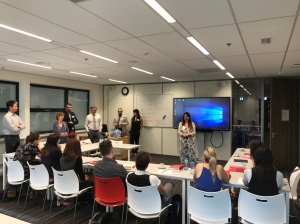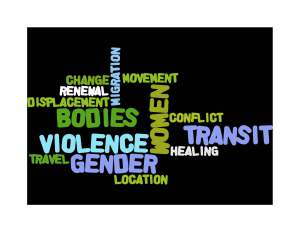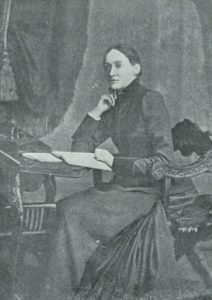Noêlle Ffrench Davies: A Transnational Irish Polymath
S Morgan

Dr. Noēlle Davies (1889-1983), née Ffrench, of Mount Talbot, Co. Roscommon, was a 20th Century intellectual, educationist, litterateur and political activist across Ireland, Wales, Denmark and Europe. Her story is largely unexplored. Using transnational sources, we can trace and assemble her 50 years’ intellectual output. This has four strands: her life-long commitment to education that was both practical and national; seminal intellectual and political collaboration building a modern Welsh nationalism with her husband, Dr. D.J. (‘Dai’) Davies (1893-1956); her own transnational political writings; and Noëlle’s personal literary output. Read More
IASIL 2018: Reimaging Traditions
Dr Lindsay Janssen

This year’s IASIL (International Association for the Study of Irish Literature) conference, ‘Reimaging Traditions’ was held at Radboud University, Nijmegen (the Netherlands; RU). RU is my alma mater and although I do not work there anymore, I was asked to co-organise the conference. A great opportunity to work together with my former colleagues: Marguérite Corporaal (main organiser), Christopher Cusack, Ruud van den Beuken and Chris Louttit, among others. The conference team also included a life-saving team of student assistants. Although I greatly appreciate their hard work and good company, I am not going to mention everybody involved; this blog post is not my personal Oscar speech. And besides, the full team (and programme) can be found at www.ru.nl/iasil2018/. My apologies if this piece is going to sound bit laudatory: truth be told, of course we had the usual bumps in the road in preparing for the conference, but in contrast to previous ones we organised, this conference itself was relatively stress-free and thus even more enjoyable. Read More
“Which is Kit?”: Discovering Kathleen Blake Coleman
By Tara Giddens, University of Limerick

I was first introduced to Kathleen Blake Coleman (1856-1915) by my supervisor when discussing PhD topics. Coleman was an eminent journalist in Canada and the United States at the end of the nineteenth and early twentieth century. She wrote the column “Woman’s Kingdom” for The Toronto Daily Mail, which later became The Daily Mail and Empire, from 1889 to 1911. After leaving the paper, Coleman became a freelancer until her death in 1915. While reading her column, I was drawn into the world of the “Woman’s Kingdom,” and instantly intrigued by Coleman’s voice and her use of both her national identity and gender to attract readers and gain popularity. One of her biggest achievements was becoming the first accredited woman war correspondent in the Spanish-American War in 1898. She was also well-known for her travels, covering the United States, Canada, and Europe as a journalist; even publishing a collection of her articles on Queen Victoria’s Diamond Jubilee in 1897. Read More
Mary Ann Allingham: An Introduction
by Dr. Niamh Hamill
MARY ANN ALLINGHAM 1820-1836
Will any one read my preface? (thought I to myself, as I sat down one evening with my Crow quill dipped in Indian ink in my fingers ready to begin an introductory page to my Friends . . . Will any one think it worthwhile to read a preface; not by an UNKNOWN AUTHOR (that would be, to be well known) but by an humble County Donegal Female. It was a stupefying thought, and the ink remained in the pen so long, that when my vanity decided that someone would read it: I was forced to clear the point of the congealed ink by my pen knife; and taking that as a lucky omen; here said I, “Female vanity, that sharp and never rusty knife, has cleared away those doubts and fears, Which ever buzz about poor authors’ ears.
—Mary Ann Allingham, Ballyshannon, 1833. [1]
Tracking ‘Norah’
Dr Lindsay Janssen
 At various occasions during the past few years, people have asked me why a Dutch Indonesian like myself is working in the field of Irish studies; where is the connection? Where does the appeal come from? Indeed, until ten years ago, I had virtually no bond to Ireland, its history, or its literature. However, that all changed when I was a graduate student: through courses on cultural memory and identity theory, I found my way to a course on Irish literature of the Great Irish Famine, wrote my MA thesis about Irish and Irish-American literature and did a Ph.D. on literary representations of the Great Irish Famine. What already fascinated me as a student and continues to captivate my attention, is how the Irish-diasporic community serves as an exemplary case for the workings of cultural identity formation under duress and for the fluidity and resourceful adaptability often considered typical to diasporic communities. Read More
At various occasions during the past few years, people have asked me why a Dutch Indonesian like myself is working in the field of Irish studies; where is the connection? Where does the appeal come from? Indeed, until ten years ago, I had virtually no bond to Ireland, its history, or its literature. However, that all changed when I was a graduate student: through courses on cultural memory and identity theory, I found my way to a course on Irish literature of the Great Irish Famine, wrote my MA thesis about Irish and Irish-American literature and did a Ph.D. on literary representations of the Great Irish Famine. What already fascinated me as a student and continues to captivate my attention, is how the Irish-diasporic community serves as an exemplary case for the workings of cultural identity formation under duress and for the fluidity and resourceful adaptability often considered typical to diasporic communities. Read More
Teaching Charlotte Riddell’s Irish Gothic Fiction
Dr Dara Downey
 About a year ago, I found myself (in a situation that will be familiar to many scholars) teaching far outside my comfort zone. I am first and foremost an Americanist, and, rightly or wrongly, have spent much of my career carefully avoiding what often seems to me to be the ideologically and emotionally fraught terrain of Irish literature in general, and of the Anglo-Irish Revival in particular. This time around, however, it was unavoidable, though thankfully, the system then in place where I was working meant that the second-year seminars I was teaching needed only a very broad association with the accompanying lectures. Read More
About a year ago, I found myself (in a situation that will be familiar to many scholars) teaching far outside my comfort zone. I am first and foremost an Americanist, and, rightly or wrongly, have spent much of my career carefully avoiding what often seems to me to be the ideologically and emotionally fraught terrain of Irish literature in general, and of the Anglo-Irish Revival in particular. This time around, however, it was unavoidable, though thankfully, the system then in place where I was working meant that the second-year seminars I was teaching needed only a very broad association with the accompanying lectures. Read More
IASIL 2017: New Horizons for Irish Literary Studies
by Rebecca Graham, University College Cork
 If, during the last week of July, you were searching for members of the International Association for the Study of Irish Literatures (IASIL), your quest would have taken you all the way to Singapore. This city-state in South East Asia may not be the first place you think of when considering a major conference of Irish writing, but this is where IASIL’s annual conference was held this year and it turned out to be the perfect setting. Read More
If, during the last week of July, you were searching for members of the International Association for the Study of Irish Literatures (IASIL), your quest would have taken you all the way to Singapore. This city-state in South East Asia may not be the first place you think of when considering a major conference of Irish writing, but this is where IASIL’s annual conference was held this year and it turned out to be the perfect setting. Read More
Expanding Connections: Bodies in Transit 2
by Dr Maureen O’Connor, UCC
 In 2015, the Spanish government funded an international research project, “Bodies in Transit/ Cuerpos en Tránsito”, involving a number of scholars interested in representations of gender and difference in the present moment, using theories of posthumanism (especially those of Rosa Braidotti and Donna Haraway) and globalisation and the transnational, with special emphasis on the implications of neoliberalism for conceptualising subjectivity. The success of this important project has inspired the directors to propose a “Bodies in Transit 2: Genders, Mobilities, and Interdependencies. Read More
In 2015, the Spanish government funded an international research project, “Bodies in Transit/ Cuerpos en Tránsito”, involving a number of scholars interested in representations of gender and difference in the present moment, using theories of posthumanism (especially those of Rosa Braidotti and Donna Haraway) and globalisation and the transnational, with special emphasis on the implications of neoliberalism for conceptualising subjectivity. The success of this important project has inspired the directors to propose a “Bodies in Transit 2: Genders, Mobilities, and Interdependencies. Read More
Impressions of RSVP’s (Research Society for Victorian Periodicals) 2017 Conference in Freiburg, Germany
Nora Moroney, Trinity College Dublin
Germany’s Black Forest, surrounding the city of Freiburg, does not conjure up immediate associations with Victorian periodicals, familiar as it is to most of us for picturesque scenery and delicious confectionary. But last month its historic university played host to RSVP’s annual conference on the theme of ‘Borders and Border Crossings’. Over seventy scholars from Europe, the UK, Ireland and the US spent three days discussing the varieties of periodical culture in the nineteenth century. There was a pleasing congruency to the theme and location too – situated close to the borders of Germany, Switzerland and France, Freiburg provided the perfect setting for such an international cohort. Read More
The Irish Identity Of George Egerton
By Eleanor Fitzsimons
 On 19 July 2017, Dr Whitney Standlee of the University of Worcester wrote a wonderful blog post for the Irish Women’s Writing Network describing her experiences at George Egerton and the fin de siècle, an inaugural two-day conference held at Loughborough University in April 2017. On day two, Dr. Standlee delivered a fascinating paper on Egerton’s ‘Portrayal of Mindscape and Landscape in the Norwegian Context’. In her blog post, she mentioned my paper on the Irish context of Egerton’s writing. Since this seems like a perfect topic for the Irish Women’s Writing Network, I have summarised my key points here. Read More
On 19 July 2017, Dr Whitney Standlee of the University of Worcester wrote a wonderful blog post for the Irish Women’s Writing Network describing her experiences at George Egerton and the fin de siècle, an inaugural two-day conference held at Loughborough University in April 2017. On day two, Dr. Standlee delivered a fascinating paper on Egerton’s ‘Portrayal of Mindscape and Landscape in the Norwegian Context’. In her blog post, she mentioned my paper on the Irish context of Egerton’s writing. Since this seems like a perfect topic for the Irish Women’s Writing Network, I have summarised my key points here. Read More



